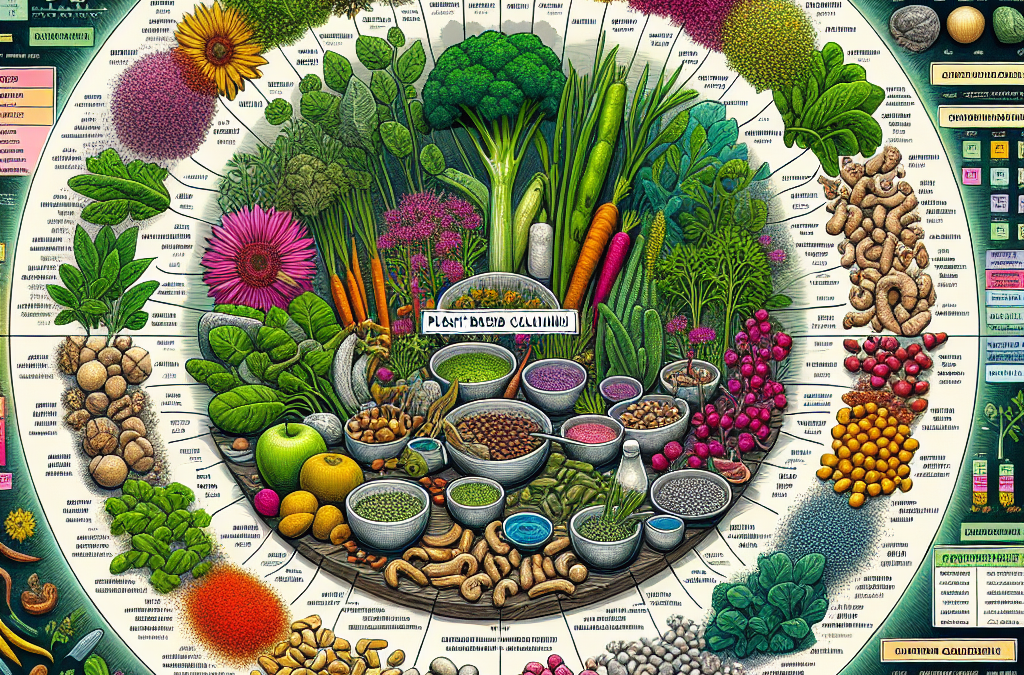Table of Contents
- 1. Prioritize Organic Whole Food Ingredients
- 2. Choose Nutrient-Dense Greens and Fruits
- 3. Incorporate Healthy Fats and Protein
- 4. Use Quality Liquids and Hydration Boosters
- 5. Add Superfoods and Adaptogens
- 6. Optimize Texture and Flavor
- 7. Experiment with Seasonal and Local Ingredients
- 8. Blend with Purpose â Timing and Consistency
- 9. Use Proper Equipment for Optimal Blending
- 10. Personalize Your Organic Whole Food Smoothie
1. Prioritize Organic Whole Food Ingredients
Choosing Organic for Purity and Nutrition
In 2025, more health-conscious consumers recognize that organic whole food ingredients significantly impact the quality of their smoothies. Organic produce is grown without synthetic pesticides, fertilizers, or genetically modified organisms (GMOs), ensuring a cleaner, more nutrient-rich base for your smoothie. When selecting ingredients, always opt for certified organic fruits, vegetables, nuts, and seeds. This not only supports sustainable farming but reduces your exposure to harmful chemicals.
Using organic ingredients also ensures that you get the maximum antioxidant content, which can be diminished by conventional farming practices. Studies show that organic produce often contains higher levels of antioxidants, vitamins, and phytochemicalsâkey nutrients that boost immunity and overall wellness, especially in 2025 where health trends lean strongly toward natural, chemical-free foods.
Remember, the foundation of a powerful organic whole food smoothie is its ingredients. Invest in high-quality organic produce and see a difference in flavor, texture, and health benefits. Your body will thank you for consuming pure, unadulterated produce that nourishes from the inside out.
2. Choose Nutrient-Dense Greens and Fruits
Maximizing Vitamins and Antioxidants
To create a truly powerful organic whole food smoothie, select ingredients that are packed with nutrients. Dark leafy greens like kale, spinach, and arugula are excellent sources of vitamins A, C, K, and minerals like magnesium and calcium. Fruits such as berries, citrus, and tropical options provide antioxidants, fiber, and natural sweetness, reducing the need for added sugars.
In 2025, the focus is on superfoods that combine taste and health benefits. Incorporate blueberries, acai, or mangos to boost your smoothieâs antioxidant profile. These enhance cognitive function, fight inflammation, and improve skin health. Remember, blending a colorful mix of greens and fruits ensures a broader spectrum of essential nutrients.
For the best results, buy organic versions of these ingredients whenever possible. Fresh, nutrient-dense produce leads to a more vibrant, energizing organic whole food smoothieâplus, it tastes better!
3. Incorporate Healthy Fats and Protein
Fueling Your Body Sustainably
Healthy fats and protein are critical in making your organic whole food smoothie more filling and balanced. In 2025, plant-based fats like avocados, chia seeds, flaxseeds, and nuts are favored for their omega-3 fatty acids and anti-inflammatory properties. These fats support brain health and hormone balance.
Adding a source of protein transforms your smoothie into a complete meal or recovery drink. Organic protein powders derived from peas, hemp, or brown rice are excellent options, especially for vegans or those with dietary restrictions. For a whole-food approach, include a handful of soaked almonds or a scoop of organic nut butter.
Healthy fats also improve flavor and texture, making your smoothie creamier and more satisfying. Consuming a balanced organic whole food smoothie with adequate fats and protein in 2025 aligns with the latest health guidelines aimed at reducing processed foods and emphasizing whole, natural ingredients.
4. Use Quality Liquids and Hydration Boosters
Choosing the Right Liquid Base
The liquid component sets the stage for your organic whole food smoothie. In 2025, options like filtered water, nut milks (almond, cashew, or macadamia), and coconut water are popular choices that add flavor without extra sugar or additives. Using unsweetened and organic liquids ensures you’re maintaining the integrity of your ingredient list.
Adding hydration boosters like herbal teas (chamomile, green tea) or infused waters infused with fruits and herbs can also give your smoothie a nutritious twist. These ingredients contain antioxidants and phytochemicals that support detoxification and immune health.
Choose your liquids wisely; they influence texture, flavor, and nutritional profile. Avoid overly processed or sugary drinks, and opt for organic options to keep your smoothie aligned with 2025 health trends.
5. Add Superfoods and Adaptogens
Enhancing Power and Resilience
Superfoods and adaptogens are game-changers for creating a powerful organic whole food smoothie. In 2025, ingredients like spirulina, maca powder, cacao nibs, and wheatgrass are embraced for their ability to boost energy, reduce inflammation, and support stress resilience.
Incorporating a teaspoon of these on a daily basis can dramatically increase the nutrient density of your smoothie while providing functional health benefits. For example, maca enhances stamina, while spirulina offers a complete protein profile. The addition of adaptogens like ashwagandha can help your body cope better with stress, a crucial benefit in todayâs fast-paced world.
Always choose organic superfoods and adaptogens to avoid contaminants and maximize their health benefits. These potent ingredients are a cornerstone of a truly powerful organic whole food smoothie in 2025.
6. Optimize Texture and Flavor
Strategies for Creamy and Delicious Smoothies
Achieving the perfect texture and flavor balance is key to enjoying your organic whole food smoothie. Use ripe, organic fruits and vegetables to naturally sweeten and flavor your blend. For creaminess, incorporate organic coconut cream, avocado, or soaked nuts.
To enhance flavor, add natural herbs like mint or basil, a dash of cinnamon, or a squeeze of fresh lemon/lime. These ingredients elevate the taste while providing added health benefits. Keep in mind, blending until smooth and creamy creates a luscious drink thatâs both satisfying and nutritious.
Experimenting with ingredient ratios and flavor add-ins can lead to delightful new variations. Remember, the best organic whole food smoothie is one you look forward to drinkingâso make it tasty and nourishing!
Huge Discount on the Best Certified Organic Whole Food Supplement!
7. Experiment with Seasonal and Local Ingredients
Supporting Sustainability and Freshness
In 2025, the trend toward seasonal and local sourcing continues to grow. Using seasonal organic ingredients ensures maximum freshness, flavor, and nutrient content in your organic whole food smoothie. Local farmersâ markets are excellent sources for these ingredients, reducing your carbon footprint.
For example, organic berries in summer, pumpkin seeds in fall, or citrus in winter can be integrated into your smoothies for variety and vitality. This not only keeps your diet interesting but also supports local economies and sustainable farming practices.
Switching up ingredients seasonally also means your body receives a wider range of nutrients throughout the year. Embrace the diversity of natureâs offerings in 2025 for a vibrant, healthy organic whole food smoothie.
8. Blend with Purpose â Timing and Consistency
When and How Often to Make Your Smoothie
Consistency is key to reaping the benefits of a powerful organic whole food smoothie. In 2025, many health experts recommend incorporating smoothies into your daily routine, ideally in the morning to kickstart your metabolism and energy levels.
Timing your smoothie around workouts or meal times can optimize nutrient absorption. Also, blending your smoothie immediately after preparation preserves maximum nutrient density, especially for delicate vitamins and phytochemicals.
Setting a routine helps you stay committed to a health-focused lifestyle. Customize your schedule to fit your needs, whether itâs a quick breakfast, post-workout recovery, or a mid-afternoon pick-me-up. Staying consistent ensures your organic whole food smoothie becomes a vital part of your wellness journey in 2025.
9. Use Proper Equipment for Optimal Blending
Choosing the Right Blender
The quality of your blender makes a significant difference. In 2025, high-powered, eco-friendly blenders that efficiently break down fibrous fruits and vegetables are popular. Investing in a blender with at least 1,000 watts of power ensures a smooth, creamy texture every time, without chunks.
Look for models with multiple speed settings, durable blades, and features like self-cleaning modes. A good blender not only saves time but also preserves nutrients better, leading to a more powerful organic whole food smoothie.
Replace or upgrade your blender as neededâthis small investment can greatly improve your blending experience. Smooth, nutrient-dense smoothies depend on the right equipment to release all the goodness from your high-quality ingredients.
10. Personalize Your Organic Whole Food Smoothie
Tailoring Flavors and Nutrients to Your Needs
Personalization makes your smoothie more enjoyable and aligned with your health goals. Experiment with different ingredient combinations, adding spices, superfoods, or boosters that suit your lifestyle. For instance, add turmeric for anti-inflammatory benefits or ginger for digestion.
In 2025, customization is easier than ever with innovative blends and functional ingredients available. Tracking how various ingredients affect your energy, digestion, and overall wellness can help you refine your recipes over time.
Donât be afraid to get creativeâturn your organic whole food smoothie into a nutritional powerhouse tailored specifically for you. Personalizing your smoothie ensures that it remains a vital, enjoyable part of your health journey.
Frequently Asked Questions (FAQs)
Q1: What makes an organic whole food smoothie more powerful in 2025?
Using 100% organic ingredients that are nutrient-dense and minimally processed creates a more potent organic whole food smoothie. This approach maximizes vitamins, antioxidants, and bioactive compounds essential for optimal health in 2025.
Q2: How can I make my organic whole food smoothie more filling?
Incorporate healthy fats like avocado or nuts, and add plant-based proteins such as hemp or pea protein. These ingredients enhance satiety while providing sustained energy.
Q3: Are there any superfoods I should include in my organic whole food smoothie in 2025?
Yes. Popular superfoods include spirulina, acai, cacao, moringa, and adaptogen powders like ashwagandha. They boost antioxidant levels and overall vitality.
Q4: How often should I drink an organic whole food smoothie to see benefits?
For most people, daily consumptionâparticularly in the morningâcan improve energy, digestion, and immunity over time. Consistency is key.
Q5: Can I substitute store-bought organic ingredients for homemade ones?
While fresh homemade is best, high-quality organic store-bought ingredients are acceptable when fresh and properly stored. Always check for certification and freshness.
Conclusion
Creating a powerful organic whole food smoothie in 2025 doesn’t have to be complicated. By following these 10 expert tips, you can craft smoothies that are nutrient-rich, delicious, and tailored to your health needs. Remember, the key lies in choosing high-quality organic ingredients and blending them with purpose. Embrace personalization, experiment with seasonal produce, and invest in the right equipment to unlock the full potential of your organic whole food smoothie. Itâs a tasty, nourishing way to support your wellness journey now and into the future.
Huge Discount on the Best Certified Organic Whole Food Supplement!
Related Content
- How to Build a Whole Foods Meal Plan for Athletes
- The Ultimate Guide to 10 Powerful Whole Food Smoothies for 2025
- The Ultimate Organic Whole Food Diet Guide 2025: 10 Effective Tips to Transform Your Health
- Discover 10 Amazing Benefits of Organic Foods for Everyday Meals in 2025
- How to Use Superfoods to Boost Your Child’s Immune System




